Analysis of Financial, HR, and Legal Aspects in Hospitality: Marriott
VerifiedAdded on 2020/10/23
|15
|4782
|116
Report
AI Summary
This report examines the management of financial performance within the hospitality industry, using Marriott Hotels as a case study. It analyzes key financial metrics such as operating profit margin, return on capital employed, current ratio, and days trade receivables. The report details the implementation of a double-entry bookkeeping system, including journal entries, ledger postings, and the formation of a trial balance. Furthermore, it explores the HR life cycle, including recruitment, onboarding, development, retention, and offboarding processes, with a focus on the role of the HR executive. The report also addresses performance management plans for HR executives and the legal and ethical considerations, including specific legislation Marriott must comply with, and the impact of company, contract, and employment law on business decision-making. Finally, it examines different functional roles in the hospitality sector and methods of communication, coordination, and monitoring within specific departments, providing a comprehensive overview of financial, HR, and legal aspects of hospitality management.
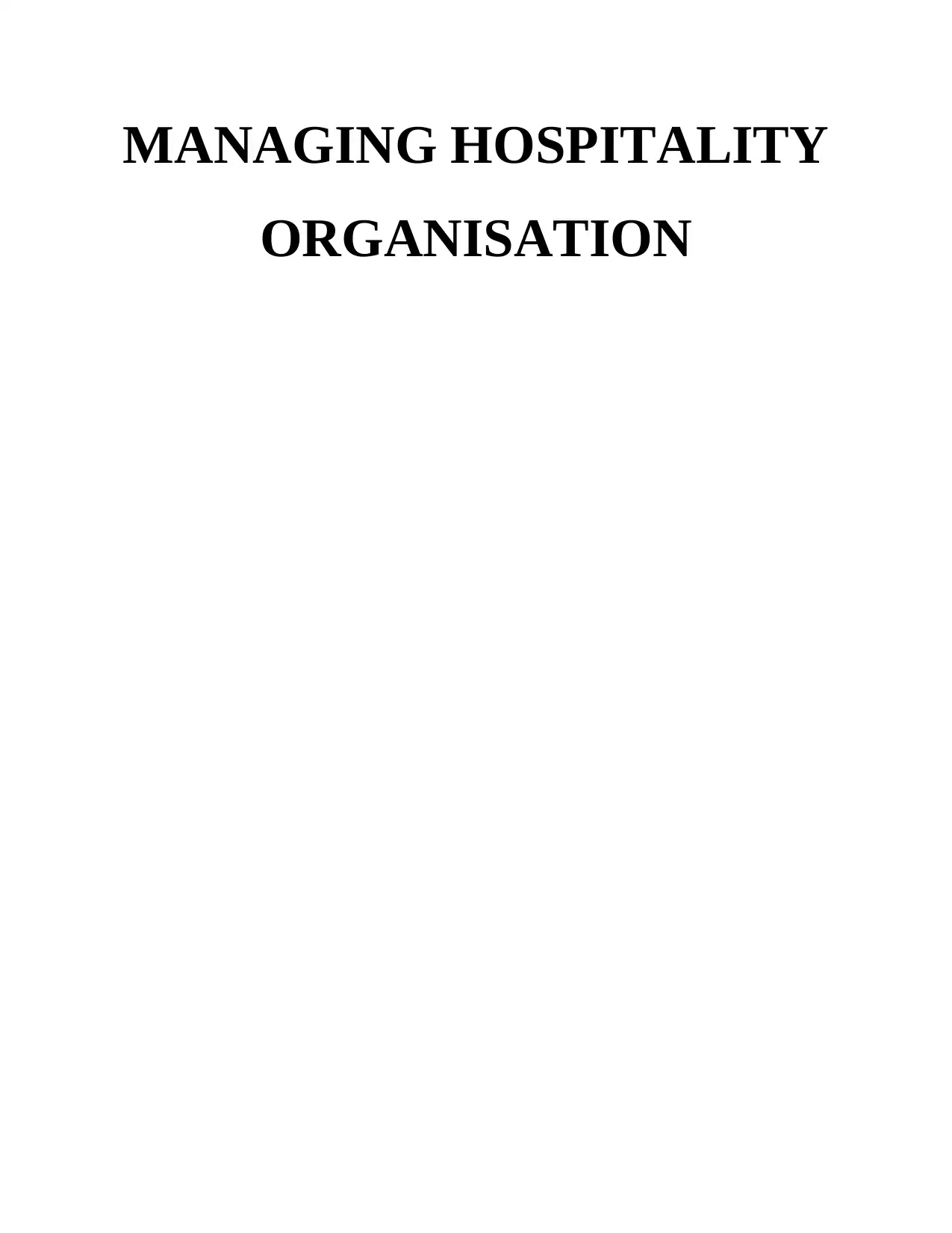
MANAGING HOSPITALITY
ORGANISATION
ORGANISATION
Paraphrase This Document
Need a fresh take? Get an instant paraphrase of this document with our AI Paraphraser
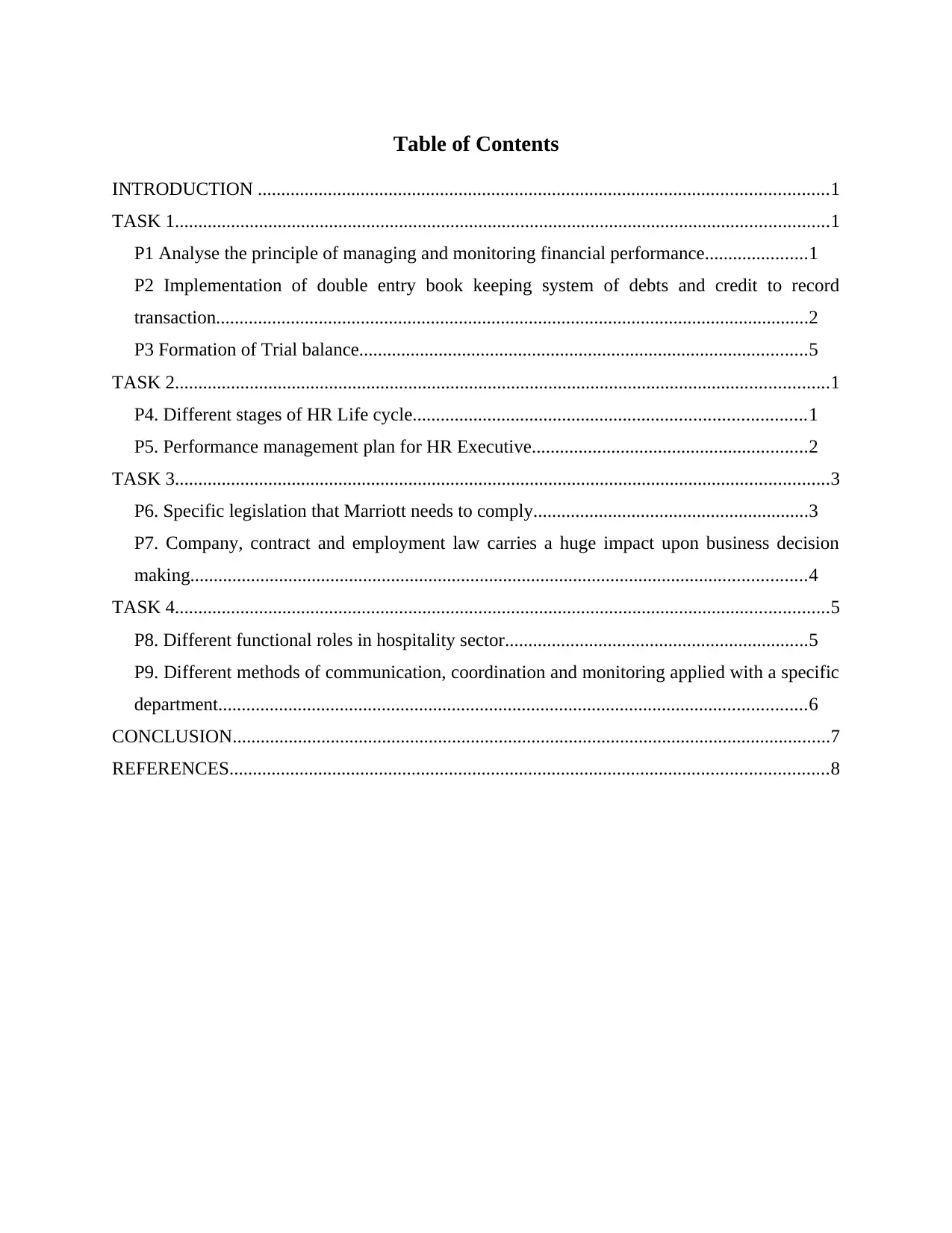
Table of Contents
INTRODUCTION ..........................................................................................................................1
TASK 1............................................................................................................................................1
P1 Analyse the principle of managing and monitoring financial performance......................1
P2 Implementation of double entry book keeping system of debts and credit to record
transaction...............................................................................................................................2
P3 Formation of Trial balance................................................................................................5
TASK 2............................................................................................................................................1
P4. Different stages of HR Life cycle....................................................................................1
P5. Performance management plan for HR Executive...........................................................2
TASK 3............................................................................................................................................3
P6. Specific legislation that Marriott needs to comply...........................................................3
P7. Company, contract and employment law carries a huge impact upon business decision
making....................................................................................................................................4
TASK 4............................................................................................................................................5
P8. Different functional roles in hospitality sector.................................................................5
P9. Different methods of communication, coordination and monitoring applied with a specific
department..............................................................................................................................6
CONCLUSION................................................................................................................................7
REFERENCES................................................................................................................................8
INTRODUCTION ..........................................................................................................................1
TASK 1............................................................................................................................................1
P1 Analyse the principle of managing and monitoring financial performance......................1
P2 Implementation of double entry book keeping system of debts and credit to record
transaction...............................................................................................................................2
P3 Formation of Trial balance................................................................................................5
TASK 2............................................................................................................................................1
P4. Different stages of HR Life cycle....................................................................................1
P5. Performance management plan for HR Executive...........................................................2
TASK 3............................................................................................................................................3
P6. Specific legislation that Marriott needs to comply...........................................................3
P7. Company, contract and employment law carries a huge impact upon business decision
making....................................................................................................................................4
TASK 4............................................................................................................................................5
P8. Different functional roles in hospitality sector.................................................................5
P9. Different methods of communication, coordination and monitoring applied with a specific
department..............................................................................................................................6
CONCLUSION................................................................................................................................7
REFERENCES................................................................................................................................8
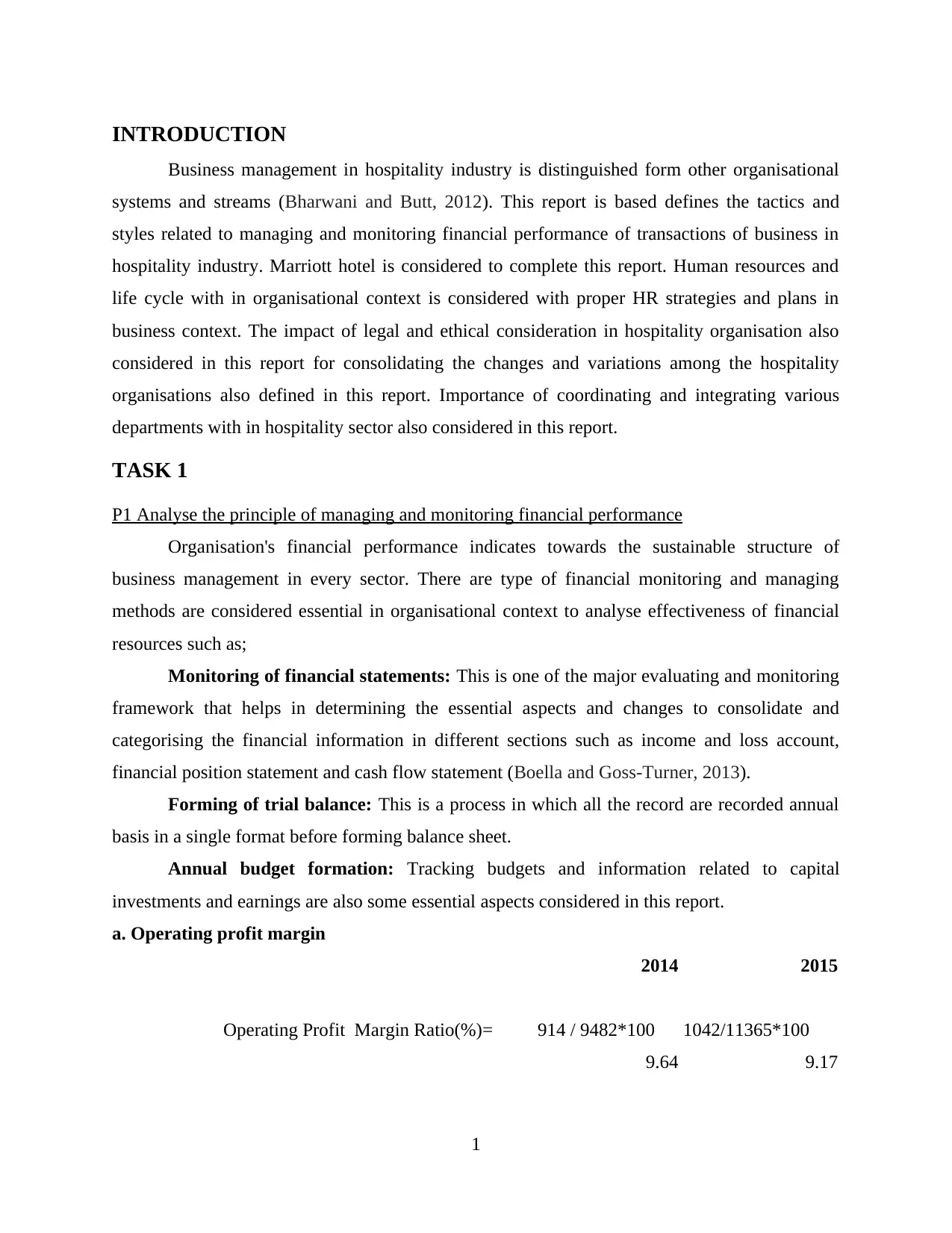
INTRODUCTION
Business management in hospitality industry is distinguished form other organisational
systems and streams (Bharwani and Butt, 2012). This report is based defines the tactics and
styles related to managing and monitoring financial performance of transactions of business in
hospitality industry. Marriott hotel is considered to complete this report. Human resources and
life cycle with in organisational context is considered with proper HR strategies and plans in
business context. The impact of legal and ethical consideration in hospitality organisation also
considered in this report for consolidating the changes and variations among the hospitality
organisations also defined in this report. Importance of coordinating and integrating various
departments with in hospitality sector also considered in this report.
TASK 1
P1 Analyse the principle of managing and monitoring financial performance
Organisation's financial performance indicates towards the sustainable structure of
business management in every sector. There are type of financial monitoring and managing
methods are considered essential in organisational context to analyse effectiveness of financial
resources such as;
Monitoring of financial statements: This is one of the major evaluating and monitoring
framework that helps in determining the essential aspects and changes to consolidate and
categorising the financial information in different sections such as income and loss account,
financial position statement and cash flow statement (Boella and Goss-Turner, 2013).
Forming of trial balance: This is a process in which all the record are recorded annual
basis in a single format before forming balance sheet.
Annual budget formation: Tracking budgets and information related to capital
investments and earnings are also some essential aspects considered in this report.
a. Operating profit margin
2014 2015
Operating Profit Margin Ratio(%)= 914 / 9482*100 1042/11365*100
9.64 9.17
1
Business management in hospitality industry is distinguished form other organisational
systems and streams (Bharwani and Butt, 2012). This report is based defines the tactics and
styles related to managing and monitoring financial performance of transactions of business in
hospitality industry. Marriott hotel is considered to complete this report. Human resources and
life cycle with in organisational context is considered with proper HR strategies and plans in
business context. The impact of legal and ethical consideration in hospitality organisation also
considered in this report for consolidating the changes and variations among the hospitality
organisations also defined in this report. Importance of coordinating and integrating various
departments with in hospitality sector also considered in this report.
TASK 1
P1 Analyse the principle of managing and monitoring financial performance
Organisation's financial performance indicates towards the sustainable structure of
business management in every sector. There are type of financial monitoring and managing
methods are considered essential in organisational context to analyse effectiveness of financial
resources such as;
Monitoring of financial statements: This is one of the major evaluating and monitoring
framework that helps in determining the essential aspects and changes to consolidate and
categorising the financial information in different sections such as income and loss account,
financial position statement and cash flow statement (Boella and Goss-Turner, 2013).
Forming of trial balance: This is a process in which all the record are recorded annual
basis in a single format before forming balance sheet.
Annual budget formation: Tracking budgets and information related to capital
investments and earnings are also some essential aspects considered in this report.
a. Operating profit margin
2014 2015
Operating Profit Margin Ratio(%)= 914 / 9482*100 1042/11365*100
9.64 9.17
1
⊘ This is a preview!⊘
Do you want full access?
Subscribe today to unlock all pages.

Trusted by 1+ million students worldwide
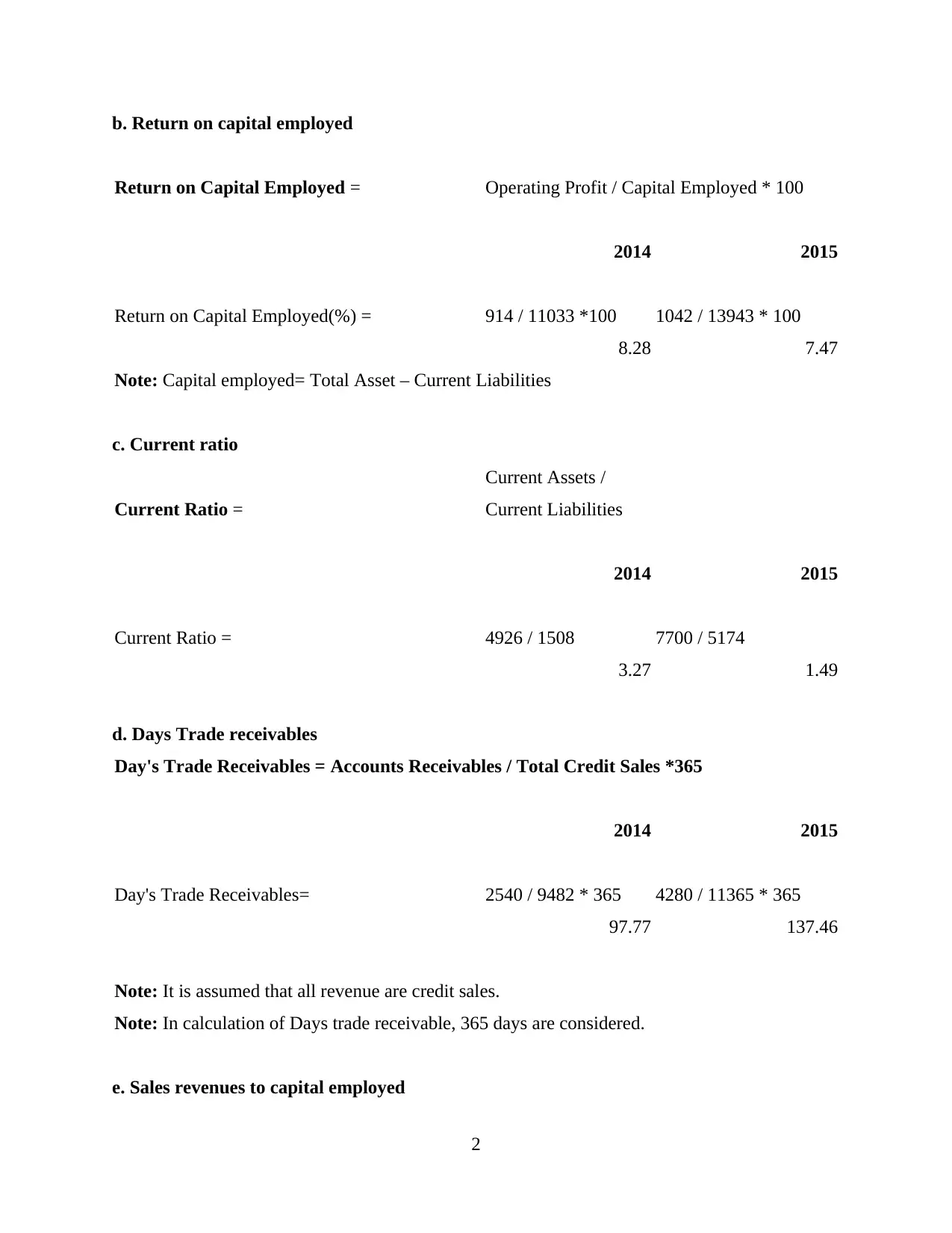
b. Return on capital employed
Return on Capital Employed = Operating Profit / Capital Employed * 100
2014 2015
Return on Capital Employed(%) = 914 / 11033 *100 1042 / 13943 * 100
8.28 7.47
Note: Capital employed= Total Asset – Current Liabilities
c. Current ratio
Current Ratio =
Current Assets /
Current Liabilities
2014 2015
Current Ratio = 4926 / 1508 7700 / 5174
3.27 1.49
d. Days Trade receivables
Day's Trade Receivables = Accounts Receivables / Total Credit Sales *365
2014 2015
Day's Trade Receivables= 2540 / 9482 * 365 4280 / 11365 * 365
97.77 137.46
Note: It is assumed that all revenue are credit sales.
Note: In calculation of Days trade receivable, 365 days are considered.
e. Sales revenues to capital employed
2
Return on Capital Employed = Operating Profit / Capital Employed * 100
2014 2015
Return on Capital Employed(%) = 914 / 11033 *100 1042 / 13943 * 100
8.28 7.47
Note: Capital employed= Total Asset – Current Liabilities
c. Current ratio
Current Ratio =
Current Assets /
Current Liabilities
2014 2015
Current Ratio = 4926 / 1508 7700 / 5174
3.27 1.49
d. Days Trade receivables
Day's Trade Receivables = Accounts Receivables / Total Credit Sales *365
2014 2015
Day's Trade Receivables= 2540 / 9482 * 365 4280 / 11365 * 365
97.77 137.46
Note: It is assumed that all revenue are credit sales.
Note: In calculation of Days trade receivable, 365 days are considered.
e. Sales revenues to capital employed
2
Paraphrase This Document
Need a fresh take? Get an instant paraphrase of this document with our AI Paraphraser
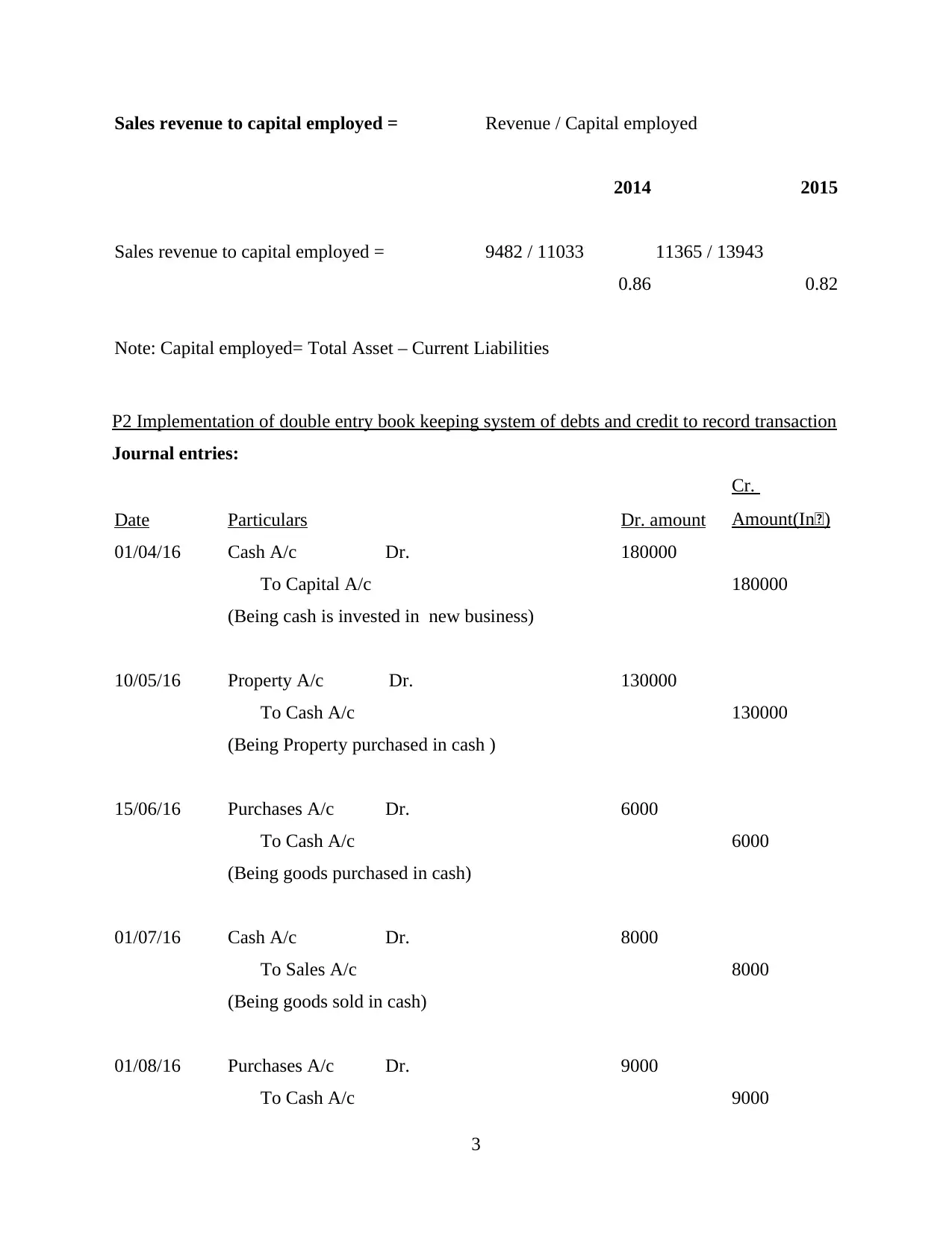
Sales revenue to capital employed = Revenue / Capital employed
2014 2015
Sales revenue to capital employed = 9482 / 11033 11365 / 13943
0.86 0.82
Note: Capital employed= Total Asset – Current Liabilities
P2 Implementation of double entry book keeping system of debts and credit to record transaction
Journal entries:
Date Particulars Dr. amount
Cr.
Amount(In£)
01/04/16 Cash A/c Dr. 180000
To Capital A/c 180000
(Being cash is invested in new business)
10/05/16 Property A/c Dr. 130000
To Cash A/c 130000
(Being Property purchased in cash )
15/06/16 Purchases A/c Dr. 6000
To Cash A/c 6000
(Being goods purchased in cash)
01/07/16 Cash A/c Dr. 8000
To Sales A/c 8000
(Being goods sold in cash)
01/08/16 Purchases A/c Dr. 9000
To Cash A/c 9000
3
2014 2015
Sales revenue to capital employed = 9482 / 11033 11365 / 13943
0.86 0.82
Note: Capital employed= Total Asset – Current Liabilities
P2 Implementation of double entry book keeping system of debts and credit to record transaction
Journal entries:
Date Particulars Dr. amount
Cr.
Amount(In£)
01/04/16 Cash A/c Dr. 180000
To Capital A/c 180000
(Being cash is invested in new business)
10/05/16 Property A/c Dr. 130000
To Cash A/c 130000
(Being Property purchased in cash )
15/06/16 Purchases A/c Dr. 6000
To Cash A/c 6000
(Being goods purchased in cash)
01/07/16 Cash A/c Dr. 8000
To Sales A/c 8000
(Being goods sold in cash)
01/08/16 Purchases A/c Dr. 9000
To Cash A/c 9000
3
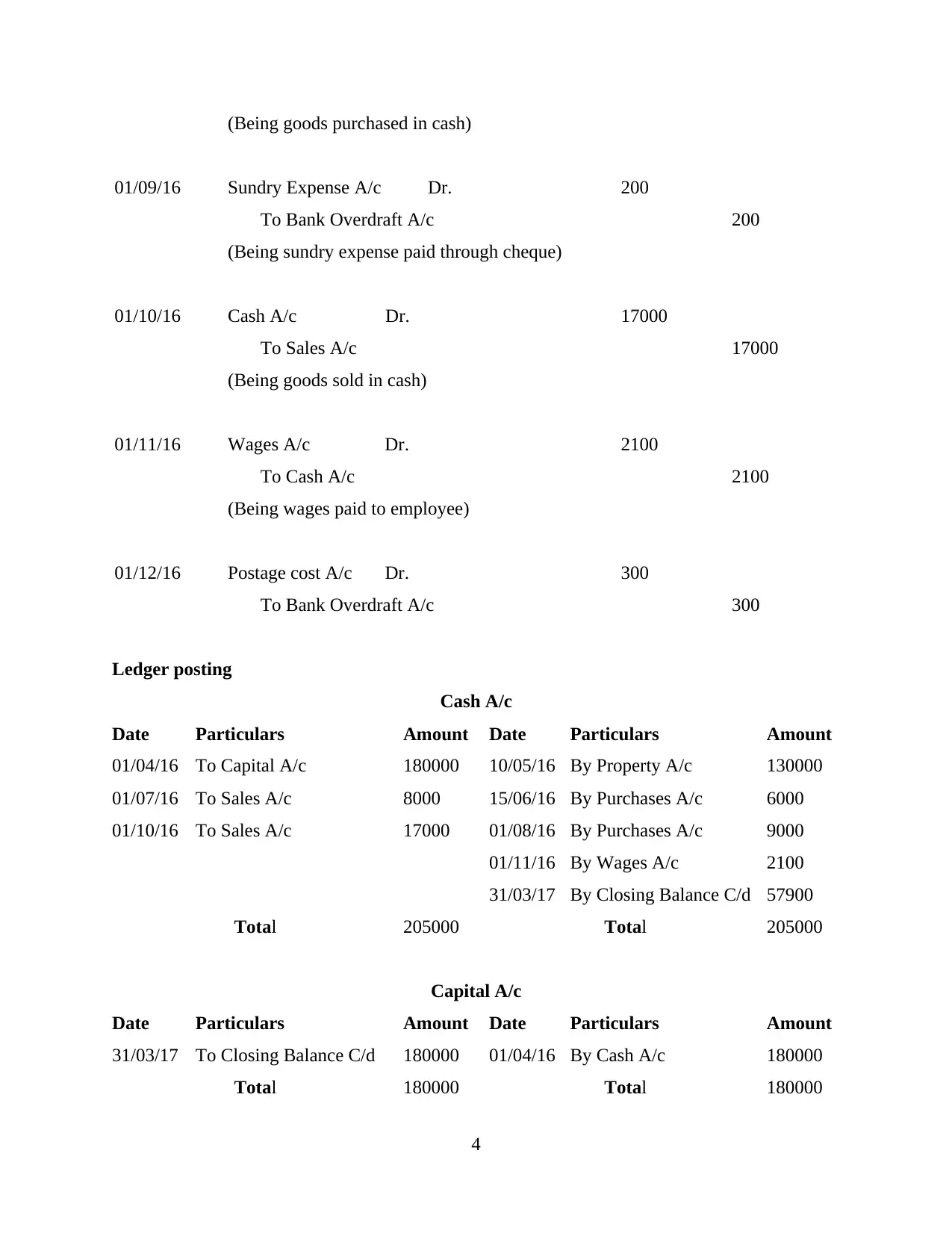
(Being goods purchased in cash)
01/09/16 Sundry Expense A/c Dr. 200
To Bank Overdraft A/c 200
(Being sundry expense paid through cheque)
01/10/16 Cash A/c Dr. 17000
To Sales A/c 17000
(Being goods sold in cash)
01/11/16 Wages A/c Dr. 2100
To Cash A/c 2100
(Being wages paid to employee)
01/12/16 Postage cost A/c Dr. 300
To Bank Overdraft A/c 300
Ledger posting
Cash A/c
Date Particulars Amount Date Particulars Amount
01/04/16 To Capital A/c 180000 10/05/16 By Property A/c 130000
01/07/16 To Sales A/c 8000 15/06/16 By Purchases A/c 6000
01/10/16 To Sales A/c 17000 01/08/16 By Purchases A/c 9000
01/11/16 By Wages A/c 2100
31/03/17 By Closing Balance C/d 57900
Total 205000 Total 205000
Capital A/c
Date Particulars Amount Date Particulars Amount
31/03/17 To Closing Balance C/d 180000 01/04/16 By Cash A/c 180000
Total 180000 Total 180000
4
01/09/16 Sundry Expense A/c Dr. 200
To Bank Overdraft A/c 200
(Being sundry expense paid through cheque)
01/10/16 Cash A/c Dr. 17000
To Sales A/c 17000
(Being goods sold in cash)
01/11/16 Wages A/c Dr. 2100
To Cash A/c 2100
(Being wages paid to employee)
01/12/16 Postage cost A/c Dr. 300
To Bank Overdraft A/c 300
Ledger posting
Cash A/c
Date Particulars Amount Date Particulars Amount
01/04/16 To Capital A/c 180000 10/05/16 By Property A/c 130000
01/07/16 To Sales A/c 8000 15/06/16 By Purchases A/c 6000
01/10/16 To Sales A/c 17000 01/08/16 By Purchases A/c 9000
01/11/16 By Wages A/c 2100
31/03/17 By Closing Balance C/d 57900
Total 205000 Total 205000
Capital A/c
Date Particulars Amount Date Particulars Amount
31/03/17 To Closing Balance C/d 180000 01/04/16 By Cash A/c 180000
Total 180000 Total 180000
4
⊘ This is a preview!⊘
Do you want full access?
Subscribe today to unlock all pages.

Trusted by 1+ million students worldwide
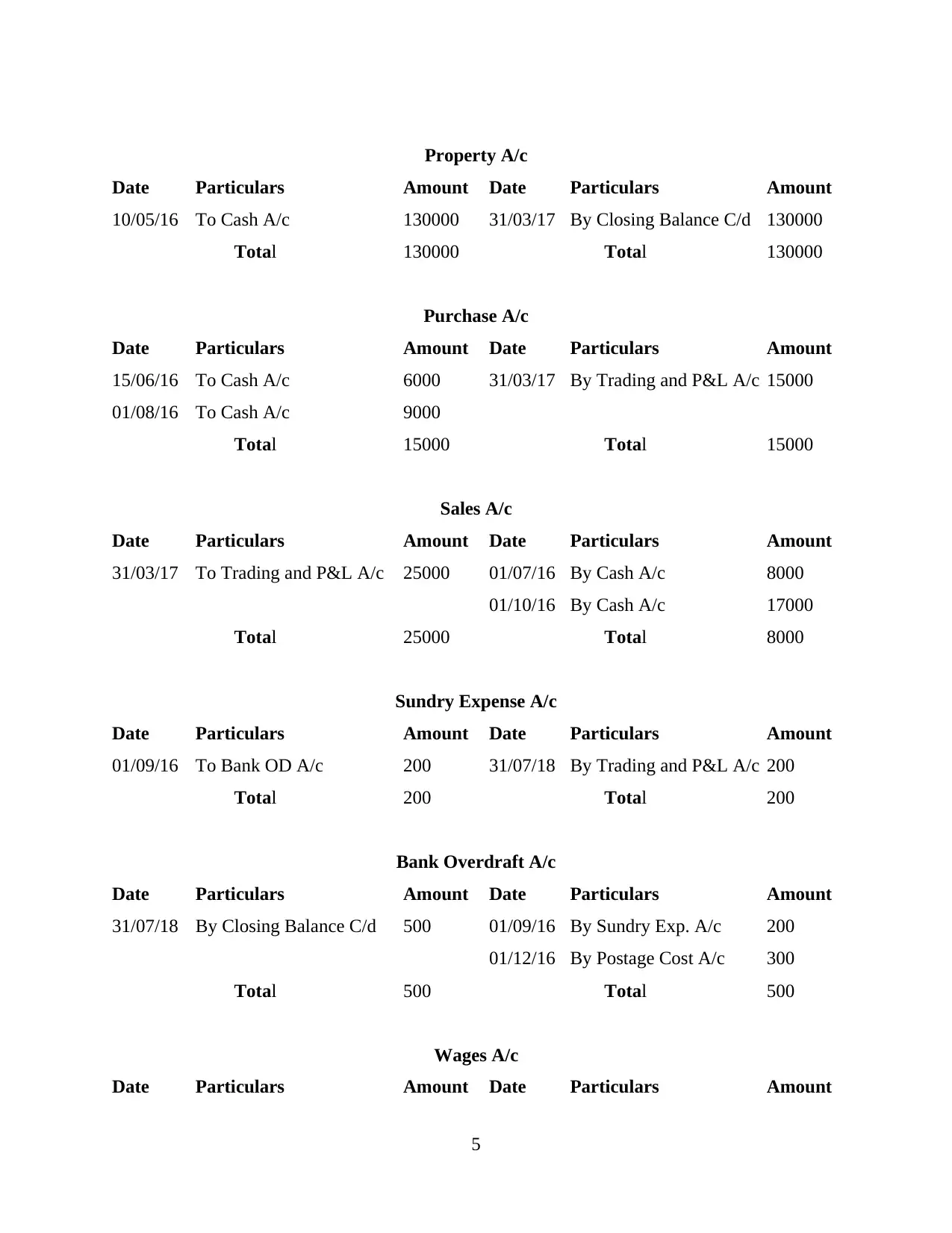
Property A/c
Date Particulars Amount Date Particulars Amount
10/05/16 To Cash A/c 130000 31/03/17 By Closing Balance C/d 130000
Total 130000 Total 130000
Purchase A/c
Date Particulars Amount Date Particulars Amount
15/06/16 To Cash A/c 6000 31/03/17 By Trading and P&L A/c 15000
01/08/16 To Cash A/c 9000
Total 15000 Total 15000
Sales A/c
Date Particulars Amount Date Particulars Amount
31/03/17 To Trading and P&L A/c 25000 01/07/16 By Cash A/c 8000
01/10/16 By Cash A/c 17000
Total 25000 Total 8000
Sundry Expense A/c
Date Particulars Amount Date Particulars Amount
01/09/16 To Bank OD A/c 200 31/07/18 By Trading and P&L A/c 200
Total 200 Total 200
Bank Overdraft A/c
Date Particulars Amount Date Particulars Amount
31/07/18 By Closing Balance C/d 500 01/09/16 By Sundry Exp. A/c 200
01/12/16 By Postage Cost A/c 300
Total 500 Total 500
Wages A/c
Date Particulars Amount Date Particulars Amount
5
Date Particulars Amount Date Particulars Amount
10/05/16 To Cash A/c 130000 31/03/17 By Closing Balance C/d 130000
Total 130000 Total 130000
Purchase A/c
Date Particulars Amount Date Particulars Amount
15/06/16 To Cash A/c 6000 31/03/17 By Trading and P&L A/c 15000
01/08/16 To Cash A/c 9000
Total 15000 Total 15000
Sales A/c
Date Particulars Amount Date Particulars Amount
31/03/17 To Trading and P&L A/c 25000 01/07/16 By Cash A/c 8000
01/10/16 By Cash A/c 17000
Total 25000 Total 8000
Sundry Expense A/c
Date Particulars Amount Date Particulars Amount
01/09/16 To Bank OD A/c 200 31/07/18 By Trading and P&L A/c 200
Total 200 Total 200
Bank Overdraft A/c
Date Particulars Amount Date Particulars Amount
31/07/18 By Closing Balance C/d 500 01/09/16 By Sundry Exp. A/c 200
01/12/16 By Postage Cost A/c 300
Total 500 Total 500
Wages A/c
Date Particulars Amount Date Particulars Amount
5
Paraphrase This Document
Need a fresh take? Get an instant paraphrase of this document with our AI Paraphraser
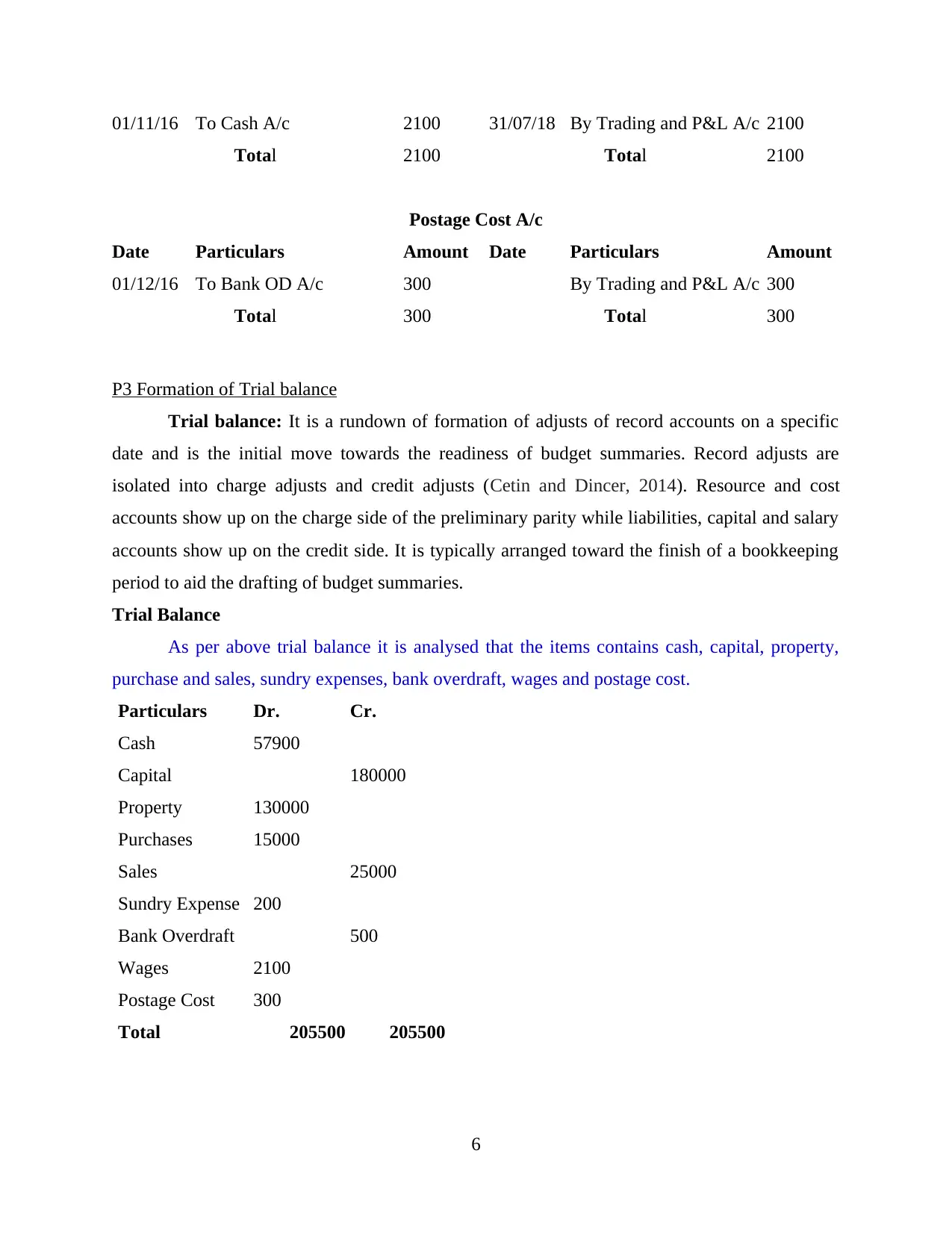
01/11/16 To Cash A/c 2100 31/07/18 By Trading and P&L A/c 2100
Total 2100 Total 2100
Postage Cost A/c
Date Particulars Amount Date Particulars Amount
01/12/16 To Bank OD A/c 300 By Trading and P&L A/c 300
Total 300 Total 300
P3 Formation of Trial balance
Trial balance: It is a rundown of formation of adjusts of record accounts on a specific
date and is the initial move towards the readiness of budget summaries. Record adjusts are
isolated into charge adjusts and credit adjusts (Cetin and Dincer, 2014). Resource and cost
accounts show up on the charge side of the preliminary parity while liabilities, capital and salary
accounts show up on the credit side. It is typically arranged toward the finish of a bookkeeping
period to aid the drafting of budget summaries.
Trial Balance
As per above trial balance it is analysed that the items contains cash, capital, property,
purchase and sales, sundry expenses, bank overdraft, wages and postage cost.
Particulars Dr. Cr.
Cash 57900
Capital 180000
Property 130000
Purchases 15000
Sales 25000
Sundry Expense 200
Bank Overdraft 500
Wages 2100
Postage Cost 300
Total 205500 205500
6
Total 2100 Total 2100
Postage Cost A/c
Date Particulars Amount Date Particulars Amount
01/12/16 To Bank OD A/c 300 By Trading and P&L A/c 300
Total 300 Total 300
P3 Formation of Trial balance
Trial balance: It is a rundown of formation of adjusts of record accounts on a specific
date and is the initial move towards the readiness of budget summaries. Record adjusts are
isolated into charge adjusts and credit adjusts (Cetin and Dincer, 2014). Resource and cost
accounts show up on the charge side of the preliminary parity while liabilities, capital and salary
accounts show up on the credit side. It is typically arranged toward the finish of a bookkeeping
period to aid the drafting of budget summaries.
Trial Balance
As per above trial balance it is analysed that the items contains cash, capital, property,
purchase and sales, sundry expenses, bank overdraft, wages and postage cost.
Particulars Dr. Cr.
Cash 57900
Capital 180000
Property 130000
Purchases 15000
Sales 25000
Sundry Expense 200
Bank Overdraft 500
Wages 2100
Postage Cost 300
Total 205500 205500
6
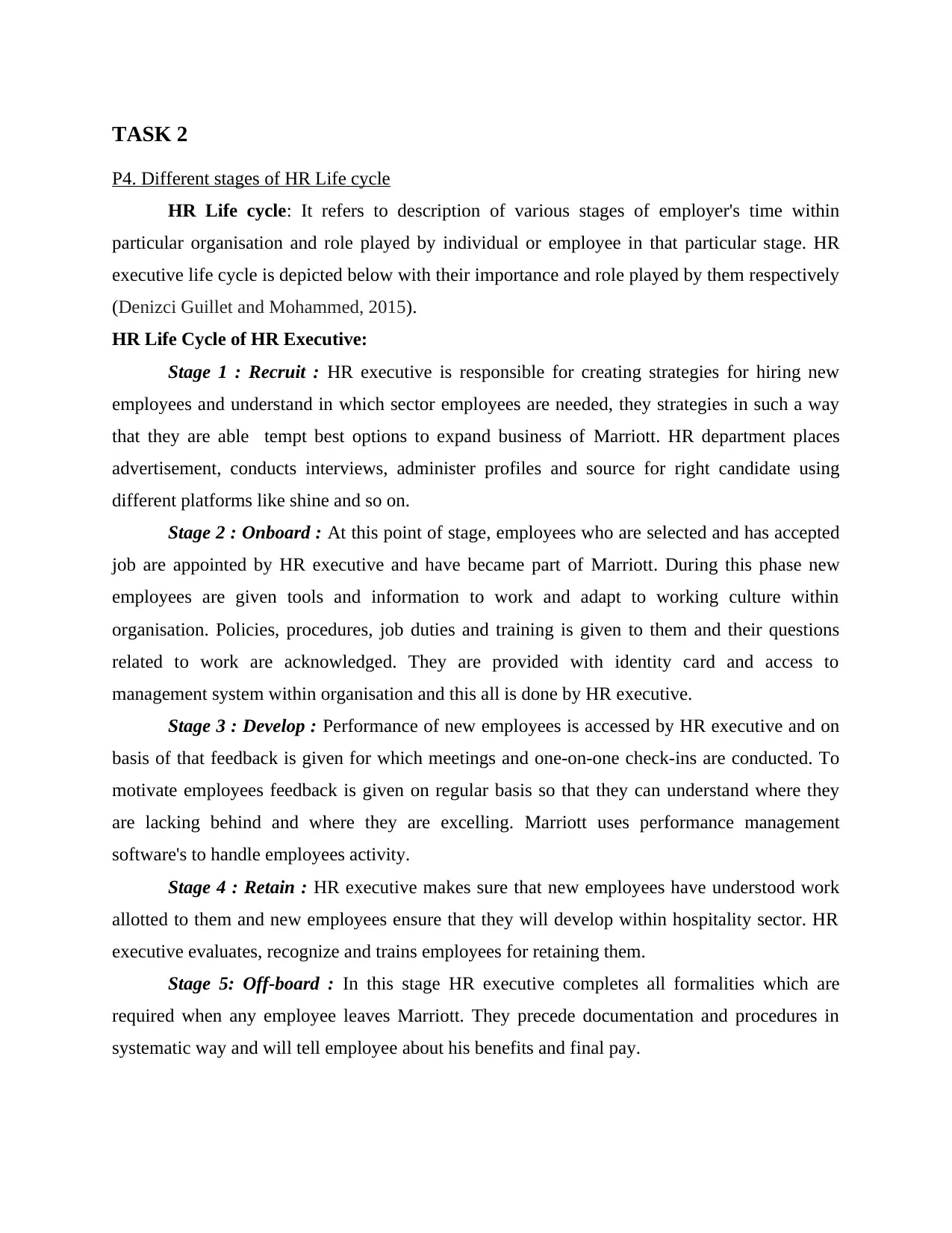
TASK 2
P4. Different stages of HR Life cycle
HR Life cycle: It refers to description of various stages of employer's time within
particular organisation and role played by individual or employee in that particular stage. HR
executive life cycle is depicted below with their importance and role played by them respectively
(Denizci Guillet and Mohammed, 2015).
HR Life Cycle of HR Executive:
Stage 1 : Recruit : HR executive is responsible for creating strategies for hiring new
employees and understand in which sector employees are needed, they strategies in such a way
that they are able tempt best options to expand business of Marriott. HR department places
advertisement, conducts interviews, administer profiles and source for right candidate using
different platforms like shine and so on.
Stage 2 : Onboard : At this point of stage, employees who are selected and has accepted
job are appointed by HR executive and have became part of Marriott. During this phase new
employees are given tools and information to work and adapt to working culture within
organisation. Policies, procedures, job duties and training is given to them and their questions
related to work are acknowledged. They are provided with identity card and access to
management system within organisation and this all is done by HR executive.
Stage 3 : Develop : Performance of new employees is accessed by HR executive and on
basis of that feedback is given for which meetings and one-on-one check-ins are conducted. To
motivate employees feedback is given on regular basis so that they can understand where they
are lacking behind and where they are excelling. Marriott uses performance management
software's to handle employees activity.
Stage 4 : Retain : HR executive makes sure that new employees have understood work
allotted to them and new employees ensure that they will develop within hospitality sector. HR
executive evaluates, recognize and trains employees for retaining them.
Stage 5: Off-board : In this stage HR executive completes all formalities which are
required when any employee leaves Marriott. They precede documentation and procedures in
systematic way and will tell employee about his benefits and final pay.
P4. Different stages of HR Life cycle
HR Life cycle: It refers to description of various stages of employer's time within
particular organisation and role played by individual or employee in that particular stage. HR
executive life cycle is depicted below with their importance and role played by them respectively
(Denizci Guillet and Mohammed, 2015).
HR Life Cycle of HR Executive:
Stage 1 : Recruit : HR executive is responsible for creating strategies for hiring new
employees and understand in which sector employees are needed, they strategies in such a way
that they are able tempt best options to expand business of Marriott. HR department places
advertisement, conducts interviews, administer profiles and source for right candidate using
different platforms like shine and so on.
Stage 2 : Onboard : At this point of stage, employees who are selected and has accepted
job are appointed by HR executive and have became part of Marriott. During this phase new
employees are given tools and information to work and adapt to working culture within
organisation. Policies, procedures, job duties and training is given to them and their questions
related to work are acknowledged. They are provided with identity card and access to
management system within organisation and this all is done by HR executive.
Stage 3 : Develop : Performance of new employees is accessed by HR executive and on
basis of that feedback is given for which meetings and one-on-one check-ins are conducted. To
motivate employees feedback is given on regular basis so that they can understand where they
are lacking behind and where they are excelling. Marriott uses performance management
software's to handle employees activity.
Stage 4 : Retain : HR executive makes sure that new employees have understood work
allotted to them and new employees ensure that they will develop within hospitality sector. HR
executive evaluates, recognize and trains employees for retaining them.
Stage 5: Off-board : In this stage HR executive completes all formalities which are
required when any employee leaves Marriott. They precede documentation and procedures in
systematic way and will tell employee about his benefits and final pay.
⊘ This is a preview!⊘
Do you want full access?
Subscribe today to unlock all pages.

Trusted by 1+ million students worldwide
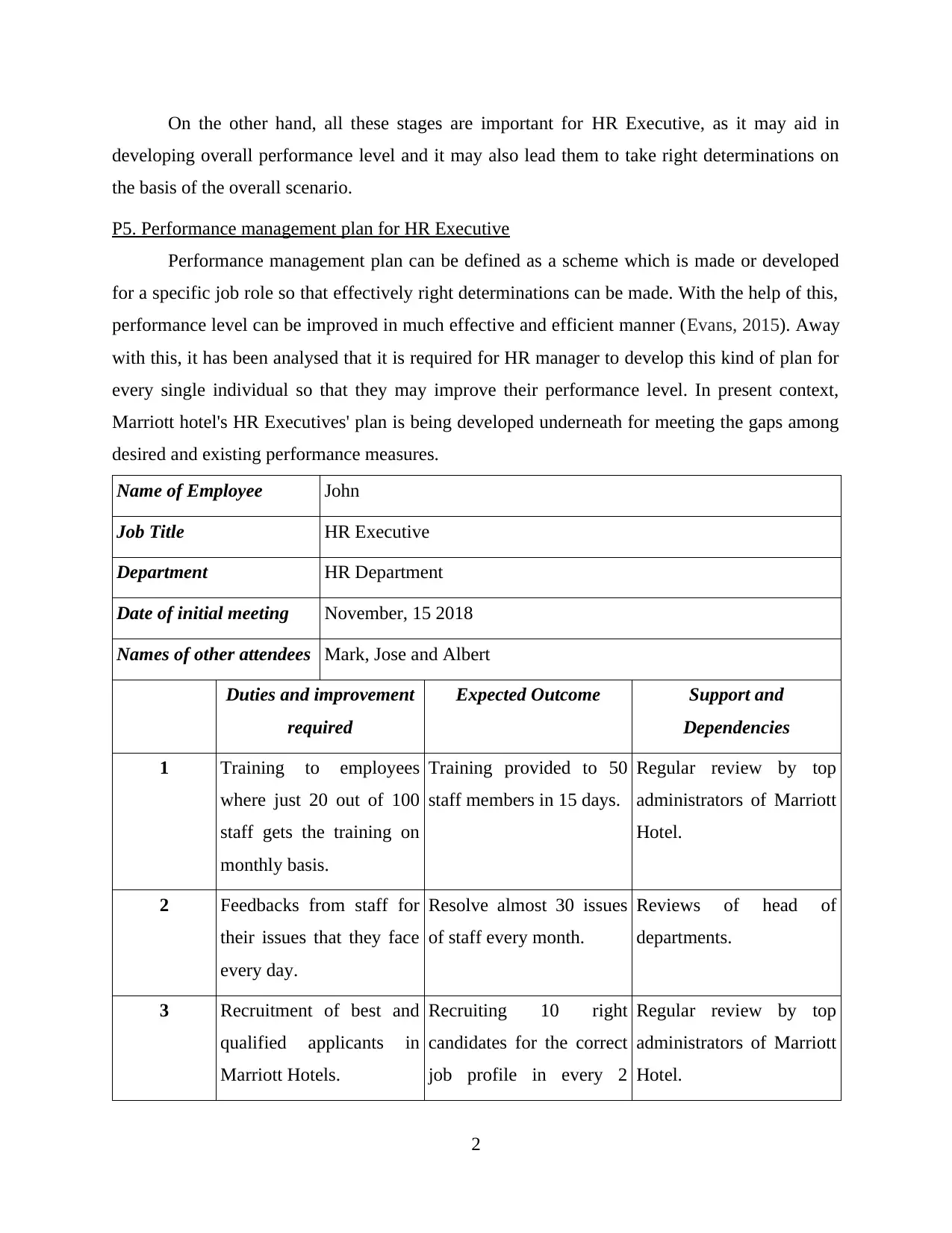
On the other hand, all these stages are important for HR Executive, as it may aid in
developing overall performance level and it may also lead them to take right determinations on
the basis of the overall scenario.
P5. Performance management plan for HR Executive
Performance management plan can be defined as a scheme which is made or developed
for a specific job role so that effectively right determinations can be made. With the help of this,
performance level can be improved in much effective and efficient manner (Evans, 2015). Away
with this, it has been analysed that it is required for HR manager to develop this kind of plan for
every single individual so that they may improve their performance level. In present context,
Marriott hotel's HR Executives' plan is being developed underneath for meeting the gaps among
desired and existing performance measures.
Name of Employee John
Job Title HR Executive
Department HR Department
Date of initial meeting November, 15 2018
Names of other attendees Mark, Jose and Albert
Duties and improvement
required
Expected Outcome Support and
Dependencies
1 Training to employees
where just 20 out of 100
staff gets the training on
monthly basis.
Training provided to 50
staff members in 15 days.
Regular review by top
administrators of Marriott
Hotel.
2 Feedbacks from staff for
their issues that they face
every day.
Resolve almost 30 issues
of staff every month.
Reviews of head of
departments.
3 Recruitment of best and
qualified applicants in
Marriott Hotels.
Recruiting 10 right
candidates for the correct
job profile in every 2
Regular review by top
administrators of Marriott
Hotel.
2
developing overall performance level and it may also lead them to take right determinations on
the basis of the overall scenario.
P5. Performance management plan for HR Executive
Performance management plan can be defined as a scheme which is made or developed
for a specific job role so that effectively right determinations can be made. With the help of this,
performance level can be improved in much effective and efficient manner (Evans, 2015). Away
with this, it has been analysed that it is required for HR manager to develop this kind of plan for
every single individual so that they may improve their performance level. In present context,
Marriott hotel's HR Executives' plan is being developed underneath for meeting the gaps among
desired and existing performance measures.
Name of Employee John
Job Title HR Executive
Department HR Department
Date of initial meeting November, 15 2018
Names of other attendees Mark, Jose and Albert
Duties and improvement
required
Expected Outcome Support and
Dependencies
1 Training to employees
where just 20 out of 100
staff gets the training on
monthly basis.
Training provided to 50
staff members in 15 days.
Regular review by top
administrators of Marriott
Hotel.
2 Feedbacks from staff for
their issues that they face
every day.
Resolve almost 30 issues
of staff every month.
Reviews of head of
departments.
3 Recruitment of best and
qualified applicants in
Marriott Hotels.
Recruiting 10 right
candidates for the correct
job profile in every 2
Regular review by top
administrators of Marriott
Hotel.
2
Paraphrase This Document
Need a fresh take? Get an instant paraphrase of this document with our AI Paraphraser
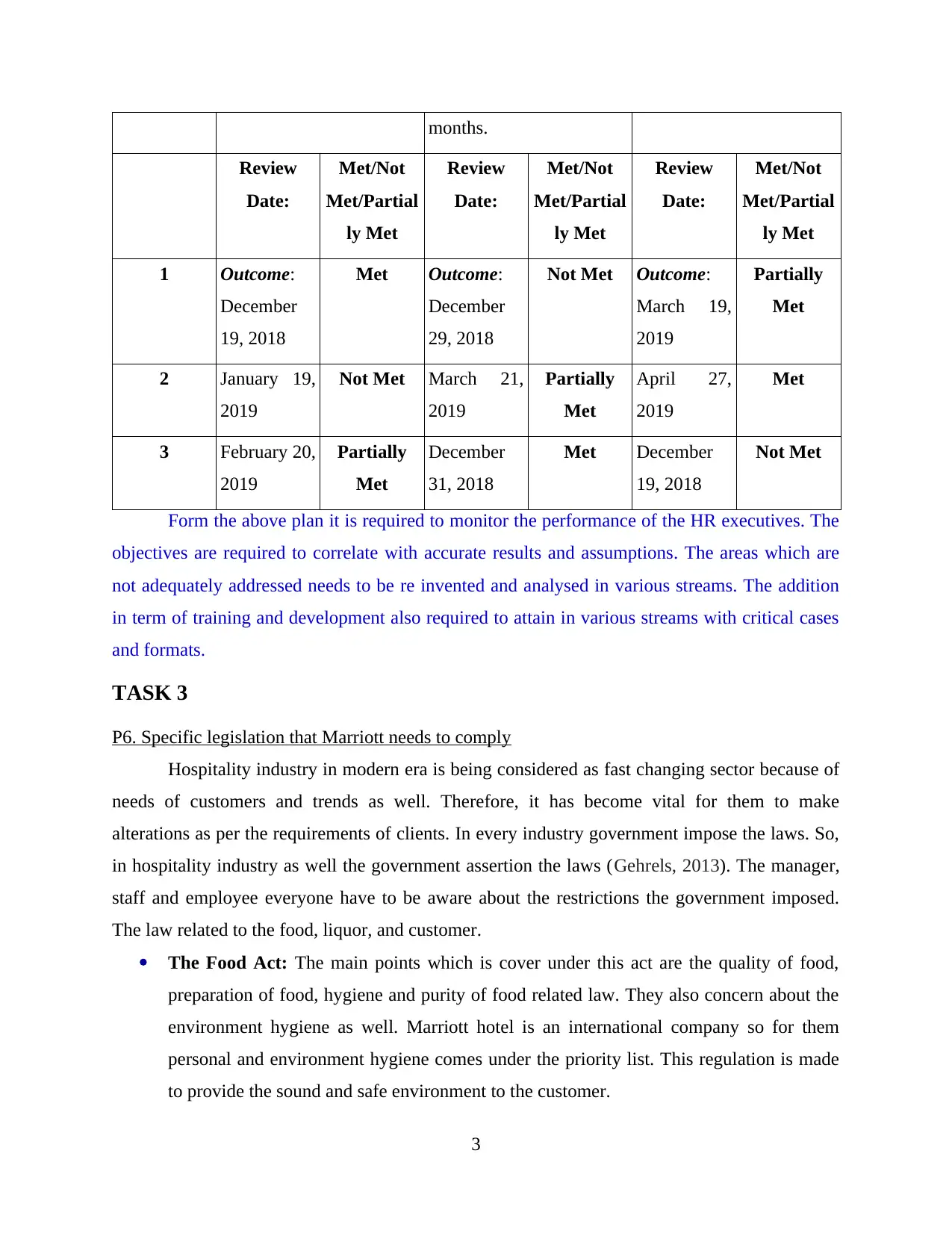
months.
Review
Date:
Met/Not
Met/Partial
ly Met
Review
Date:
Met/Not
Met/Partial
ly Met
Review
Date:
Met/Not
Met/Partial
ly Met
1 Outcome:
December
19, 2018
Met Outcome:
December
29, 2018
Not Met Outcome:
March 19,
2019
Partially
Met
2 January 19,
2019
Not Met March 21,
2019
Partially
Met
April 27,
2019
Met
3 February 20,
2019
Partially
Met
December
31, 2018
Met December
19, 2018
Not Met
Form the above plan it is required to monitor the performance of the HR executives. The
objectives are required to correlate with accurate results and assumptions. The areas which are
not adequately addressed needs to be re invented and analysed in various streams. The addition
in term of training and development also required to attain in various streams with critical cases
and formats.
TASK 3
P6. Specific legislation that Marriott needs to comply
Hospitality industry in modern era is being considered as fast changing sector because of
needs of customers and trends as well. Therefore, it has become vital for them to make
alterations as per the requirements of clients. In every industry government impose the laws. So,
in hospitality industry as well the government assertion the laws (Gehrels, 2013). The manager,
staff and employee everyone have to be aware about the restrictions the government imposed.
The law related to the food, liquor, and customer.
The Food Act: The main points which is cover under this act are the quality of food,
preparation of food, hygiene and purity of food related law. They also concern about the
environment hygiene as well. Marriott hotel is an international company so for them
personal and environment hygiene comes under the priority list. This regulation is made
to provide the sound and safe environment to the customer.
3
Review
Date:
Met/Not
Met/Partial
ly Met
Review
Date:
Met/Not
Met/Partial
ly Met
Review
Date:
Met/Not
Met/Partial
ly Met
1 Outcome:
December
19, 2018
Met Outcome:
December
29, 2018
Not Met Outcome:
March 19,
2019
Partially
Met
2 January 19,
2019
Not Met March 21,
2019
Partially
Met
April 27,
2019
Met
3 February 20,
2019
Partially
Met
December
31, 2018
Met December
19, 2018
Not Met
Form the above plan it is required to monitor the performance of the HR executives. The
objectives are required to correlate with accurate results and assumptions. The areas which are
not adequately addressed needs to be re invented and analysed in various streams. The addition
in term of training and development also required to attain in various streams with critical cases
and formats.
TASK 3
P6. Specific legislation that Marriott needs to comply
Hospitality industry in modern era is being considered as fast changing sector because of
needs of customers and trends as well. Therefore, it has become vital for them to make
alterations as per the requirements of clients. In every industry government impose the laws. So,
in hospitality industry as well the government assertion the laws (Gehrels, 2013). The manager,
staff and employee everyone have to be aware about the restrictions the government imposed.
The law related to the food, liquor, and customer.
The Food Act: The main points which is cover under this act are the quality of food,
preparation of food, hygiene and purity of food related law. They also concern about the
environment hygiene as well. Marriott hotel is an international company so for them
personal and environment hygiene comes under the priority list. This regulation is made
to provide the sound and safe environment to the customer.
3
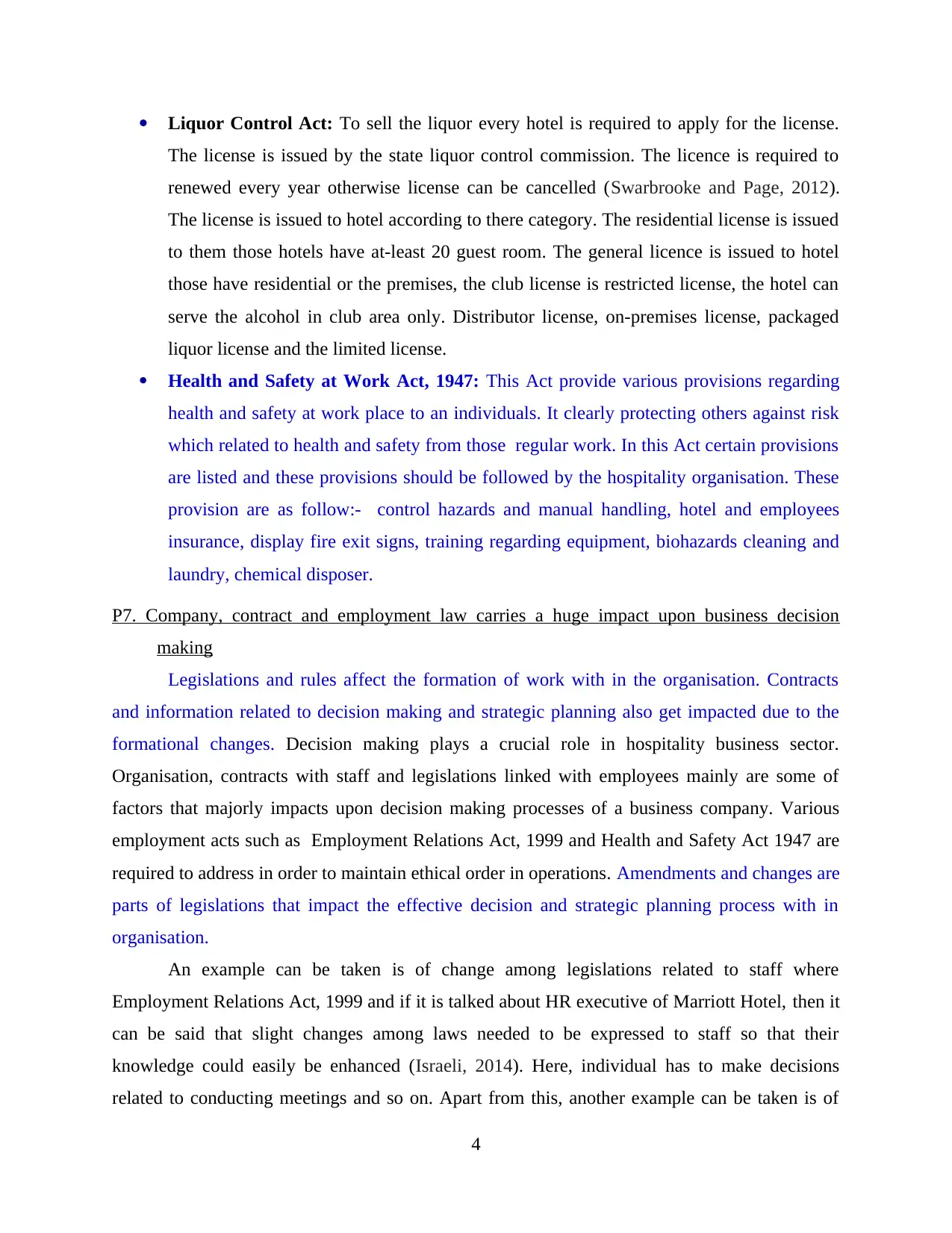
Liquor Control Act: To sell the liquor every hotel is required to apply for the license.
The license is issued by the state liquor control commission. The licence is required to
renewed every year otherwise license can be cancelled (Swarbrooke and Page, 2012).
The license is issued to hotel according to there category. The residential license is issued
to them those hotels have at-least 20 guest room. The general licence is issued to hotel
those have residential or the premises, the club license is restricted license, the hotel can
serve the alcohol in club area only. Distributor license, on-premises license, packaged
liquor license and the limited license.
Health and Safety at Work Act, 1947: This Act provide various provisions regarding
health and safety at work place to an individuals. It clearly protecting others against risk
which related to health and safety from those regular work. In this Act certain provisions
are listed and these provisions should be followed by the hospitality organisation. These
provision are as follow:- control hazards and manual handling, hotel and employees
insurance, display fire exit signs, training regarding equipment, biohazards cleaning and
laundry, chemical disposer.
P7. Company, contract and employment law carries a huge impact upon business decision
making
Legislations and rules affect the formation of work with in the organisation. Contracts
and information related to decision making and strategic planning also get impacted due to the
formational changes. Decision making plays a crucial role in hospitality business sector.
Organisation, contracts with staff and legislations linked with employees mainly are some of
factors that majorly impacts upon decision making processes of a business company. Various
employment acts such as Employment Relations Act, 1999 and Health and Safety Act 1947 are
required to address in order to maintain ethical order in operations. Amendments and changes are
parts of legislations that impact the effective decision and strategic planning process with in
organisation.
An example can be taken is of change among legislations related to staff where
Employment Relations Act, 1999 and if it is talked about HR executive of Marriott Hotel, then it
can be said that slight changes among laws needed to be expressed to staff so that their
knowledge could easily be enhanced (Israeli, 2014). Here, individual has to make decisions
related to conducting meetings and so on. Apart from this, another example can be taken is of
4
The license is issued by the state liquor control commission. The licence is required to
renewed every year otherwise license can be cancelled (Swarbrooke and Page, 2012).
The license is issued to hotel according to there category. The residential license is issued
to them those hotels have at-least 20 guest room. The general licence is issued to hotel
those have residential or the premises, the club license is restricted license, the hotel can
serve the alcohol in club area only. Distributor license, on-premises license, packaged
liquor license and the limited license.
Health and Safety at Work Act, 1947: This Act provide various provisions regarding
health and safety at work place to an individuals. It clearly protecting others against risk
which related to health and safety from those regular work. In this Act certain provisions
are listed and these provisions should be followed by the hospitality organisation. These
provision are as follow:- control hazards and manual handling, hotel and employees
insurance, display fire exit signs, training regarding equipment, biohazards cleaning and
laundry, chemical disposer.
P7. Company, contract and employment law carries a huge impact upon business decision
making
Legislations and rules affect the formation of work with in the organisation. Contracts
and information related to decision making and strategic planning also get impacted due to the
formational changes. Decision making plays a crucial role in hospitality business sector.
Organisation, contracts with staff and legislations linked with employees mainly are some of
factors that majorly impacts upon decision making processes of a business company. Various
employment acts such as Employment Relations Act, 1999 and Health and Safety Act 1947 are
required to address in order to maintain ethical order in operations. Amendments and changes are
parts of legislations that impact the effective decision and strategic planning process with in
organisation.
An example can be taken is of change among legislations related to staff where
Employment Relations Act, 1999 and if it is talked about HR executive of Marriott Hotel, then it
can be said that slight changes among laws needed to be expressed to staff so that their
knowledge could easily be enhanced (Israeli, 2014). Here, individual has to make decisions
related to conducting meetings and so on. Apart from this, another example can be taken is of
4
⊘ This is a preview!⊘
Do you want full access?
Subscribe today to unlock all pages.

Trusted by 1+ million students worldwide
1 out of 15
Related Documents
Your All-in-One AI-Powered Toolkit for Academic Success.
+13062052269
info@desklib.com
Available 24*7 on WhatsApp / Email
![[object Object]](/_next/static/media/star-bottom.7253800d.svg)
Unlock your academic potential
Copyright © 2020–2025 A2Z Services. All Rights Reserved. Developed and managed by ZUCOL.





